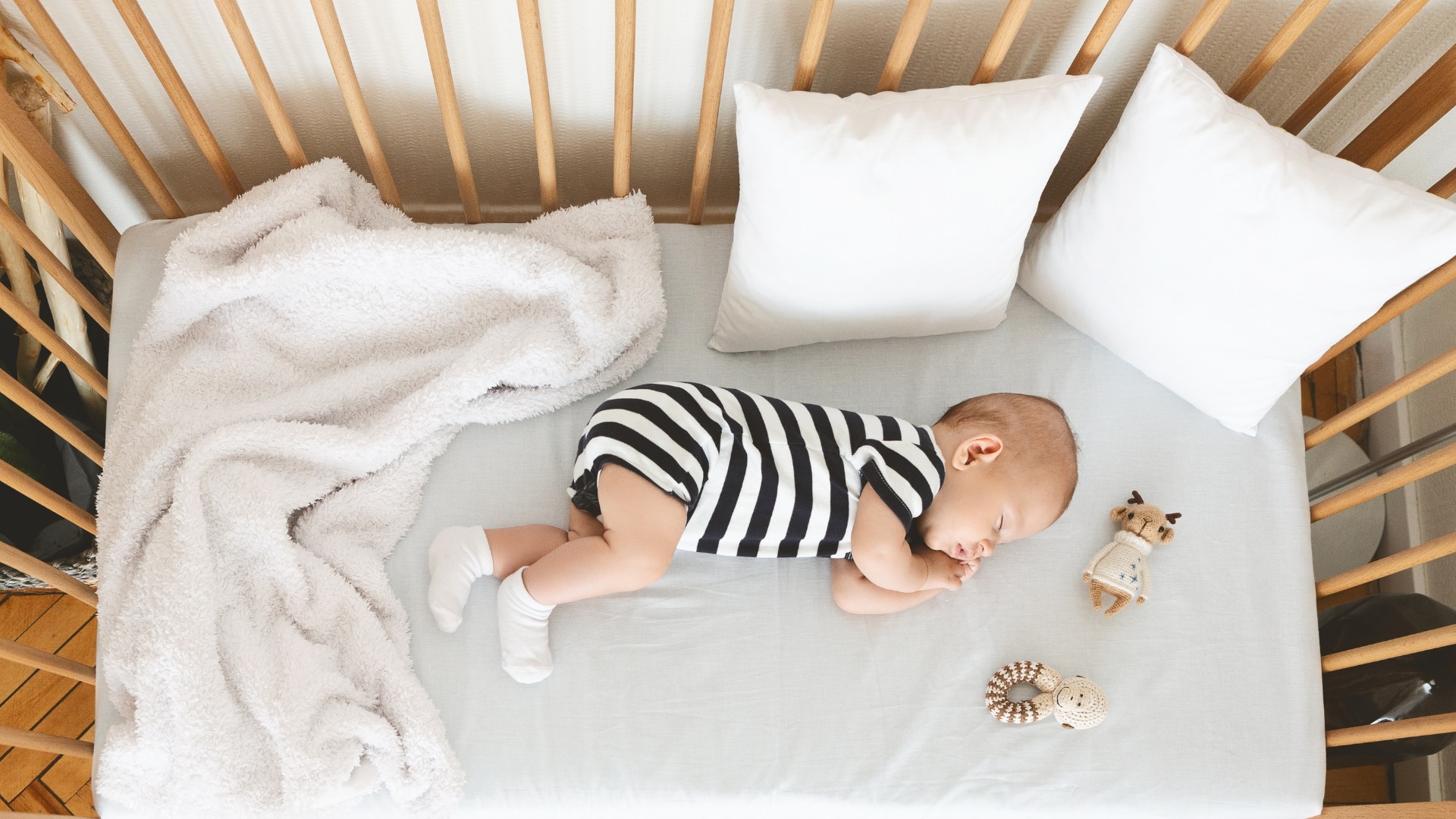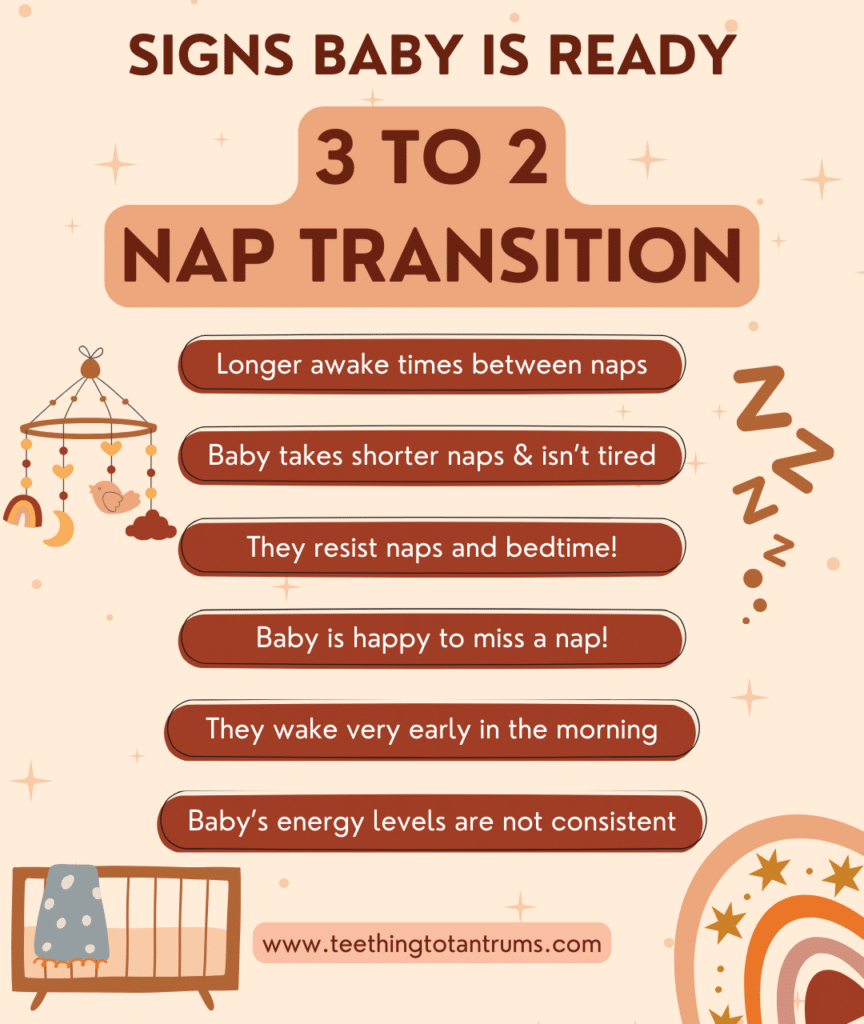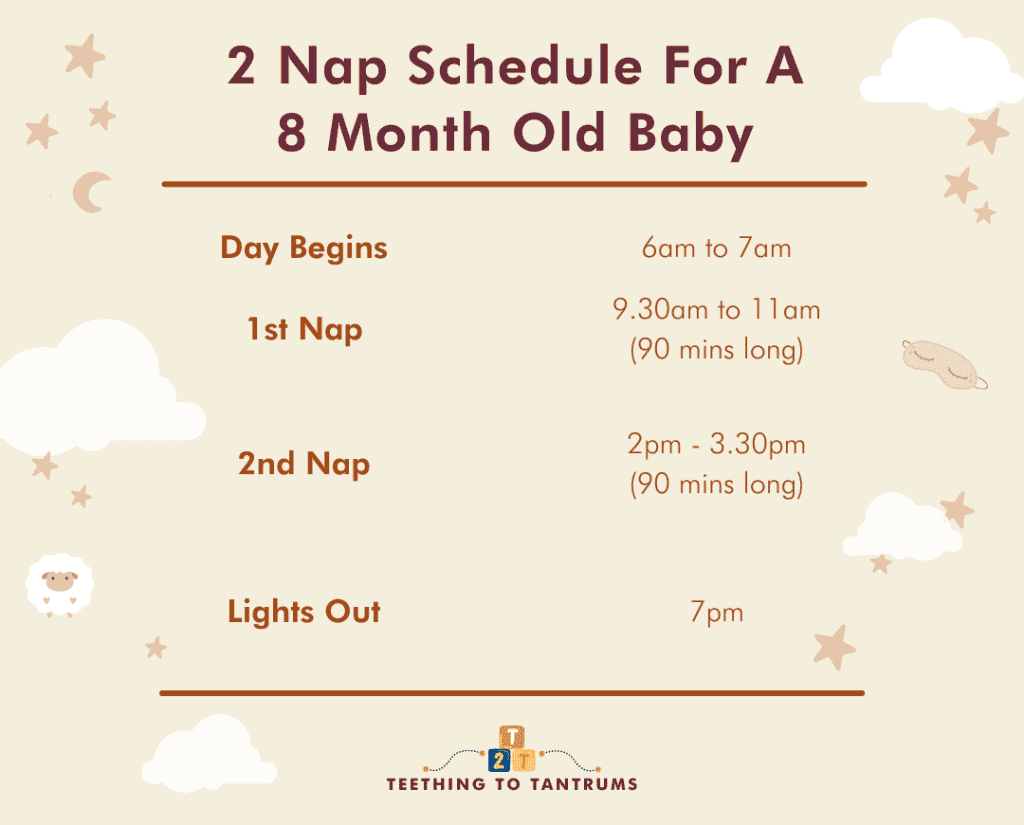The 3 to 2 nap transition is a rite of passage for every parent. As babies grow and need less sleep during the day, their nap schedule must evolve to match their changing needs. Although inevitable, the transition from three naps to two can be challenging to navigate.
Knowing what signs to look for, strategies to try, and what pitfalls to avoid will help you and your baby smoothly shift into a two-nap routine with as little disruption as possible.

Table of Contents
Key Takeaways
- Know the Signs – Be on the lookout for signs your baby is ready to transition such as longer periods of awake time, shorter naps, resisting sleep, and early morning waking. These cues mean your baby needs less daytime sleep.
- Use Proactive Strategies – Proactively adjust wake windows, implement a calming pre-nap routine, gradually shift nap times, and move bedtime earlier. These tactics will facilitate the transition to fewer naps.
- Avoid Pitfalls – Watch out for overtiredness, sleep regression, outright nap refusal, and not responding to tired cues. These traps can derail transition success so have a plan to troubleshoot them.
When Do Babies Go Through The 3 To 2 Nap Transition?
The 3 to 2 nap transition happens between 6 and 9 months of age. However, most babies will drop their third nap around 8 months old. You will notice your baby needs to drop a nap when they start resisting the third sleep at nap time, are taking longer to fall asleep, or wake up early from a nap.
How Long Do Nap Transitions Take?
The 3 to 2 nap transition can take anywhere from a few days to a couple of weeks, depending on your baby’s age, temperament, and sleep needs.
Nap transitions do not happen overnight and it is important to remember that this transition is a natural part of your baby’s development and may take some time to adjust. Be patient and allow your baby to gradually adapt to their new nap schedule.
Looking to get your little one to sleep quickly and effortlessly? Check out my Bedtime and Nap Cheat Sheet and master the art of making daytime naps and bedtimes as seamless as possible.
A bedtime & nap cheat sheet so good your little one will ask you to put them to bed...
Laura Williams "This is a life saver! I'm so glad I downloaded your bedtime & nap cheat sheet. My little one actually asked me to put him to bed last night! Unbelievable! Thank you so much!"
Click Here For The FREE Cheat Sheet
Signs Baby Is Ready For The 3 To 2 Nap Transition
As I mentioned earlier, most babies will resist sleeping during nap times and wake up early when they are going through a nap transition. But are there any other signs you need to look out for to know if your baby is ready to drop a nap?
- Longer awake times between naps: If your baby can stay awake for longer periods without displaying recognizable sleep cues it is usually a sign that they are ready to drop a nap.
- Shorter naps: If your baby is consistently waking earlier from their naps this is a sure sign that they need less daytime sleep and need to drop to 2 naps per day.
- Resisting sleep at naps and bedtime: A big indicator that your little one is ready to drop a nap is if they start resisting sleep at nap time and bedtime.
- Happy to miss a nap: if you are out and about and your little one misses a nap but does not get overtired as a result. This is a sure sign they are ready to drop a nap.
- Early morning waking: If your little one starts to consistently wake earlier in the mornings it can be a sign that they are getting too much daytime sleep and are ready to drop a nap.
- Baby is grumpy if they don’t nap, but restless if they do nap. A nap transition can be challenging to navigate and there may be bumps along the way. For instance, during the transition, you may notice that your baby is more tired and grumpy than usual because they need to rest. However, they will refuse to sleep because they are not ready to np when they used to. If this happens, implementing quiet time or time awake but alone in their crib will be your saving grace.
Always keep in mind that every baby is different, and some may be ready for the transition earlier or later than others.
Therefore, it is important to pay attention to your baby’s sleep cues and adjust their schedule accordingly rather than waiting for a certain age at which to make the transition.

TOP TIP: If your baby is only having a couple of days when they resist naps or show or wake early in the morning you should not jump to the conclusion that they are ready to nap transition. The sleep disruption signs should be present for a week or two before you actively start to change their routine.
Which Nap Gets Dropped When Transitioning From 3 to 2 Naps?
In my experience, when a baby moves from 3 to 2 naps, it is the last nap of the day that gets dropped. This nap is usually the shortest and least restorative of the day, and the nearest to bedtime.
By dropping the third nap, you will help consolidate your baby’s sleep schedule and ensure they sleep better at night.

Navigating The 3 To 2 Nap Transition Successfully
It can be rather daunting to think about changing baby’s sleep routine. However, if your little one is showing signs of needing to drop a nap then you will need to know how best to do navigate the change.
With a little preparation and consistency, you can make this sleep change happen smoothly. Here are some steps you can take to help your baby adjust to the 3 to 2 nap transition.
1. Create A Suitable Sleep Environment
As always, creating a suitable sleep environment is essential for your baby’s sleep quality. By 8 months of age, most of your baby’s naps should be taken in the same sleep space as their nighttime sleep.
Ensure the room is dark, quiet, and at a comfortable temperature. Use a white noise machine if needed, and make sure your baby’s crib is free of distractions.
White noise machines are a game-changer for your little one's sleep and having one that plays all night is a must. With a long-lasting battery, this compact and stylish white noise machine contains 21 non-stop relaxing noises, which will lull your little one to sleep night after night, no matter where you are!
2. Establish A Consistent Sleep Schedule
By now you should have an established and consistent sleep schedule in place. If not, now is the time to start implementing one!
During the 3 to 2 nap transition, stick to a regular wake-up time and bedtime, and aim to keep your baby’s nap times the same each day. This will help your baby’s body adjust to the new routine.
If your baby needs 3 naps on one day and 2 naps on another day, consider using quiet time in place of the last nap to help your baby calm down, relax, and reset their energy levels without needing to sleep.
Here are a few of my sleep schedules to guide you:
- 6-Month-Old Sleep And Nap Schedule
- 7-Month-Old Sleep And Nap Schedule
- 8-Month-Old Sleep And Nap Schedule
- 9-Month-Old Sleep And Nap Schedule
NOTE: Here is the American Academy of Pediatrics’s recommendations for sleep amounts for babies: Infants of 4 months to 12 months of age should have 12-16 hours of sleep per 24 hour period (including naps) regularly to promote optimal health.
3. Observe Sleep Cues During Wake Windows
Watching for your baby’s sleep cues during wake windows is very important to avoid overtiredness.
You will need to be your baby’s guide during this time and your baby must sleep when they need to.
If your baby is showing signs of tiredness, such as rubbing their eyes or yawning you should put them down for a nap regardless of what your sleep schedule suggests.
Trying to keep a tired baby awake will only result in an overtired baby which will become more difficult to handle and will certainly not help the nap transition process.
4. Extend Baby’s Wake Windows
Another good way to help your baby move from 3 naps to 2 is to gradually extend their established wake windows by 10-15 minutes daily to see if they manage to stay awake for longer.
If they can stay awake for these longer periods without getting overtired, it is a sure sign they are ready for less daytime sleep.
5. Have A Pre-Nap Routine
A pre-nap routine is just as important as a bedtime routine.
Doing a calming activity leading up to naptime and reading a book or singing a lullaby before you put your baby down can all help your little one recognize that sleep is on the way. Therefore, helping them to settle more easily.
6. Have An Earlier Bedtime
When your baby is moving from 3 naps to 2, you may need to adjust baby’s bedtime by bringing it forward by up to 60 minutes.
This is important as it will prevent your little one from becoming overtired and help them adjust to having less daytime sleep.
Aim to have your little one in bed by 7.30 pm at the latest during a nap transition.
REMEMBER: During a nap transition your baby may take 3 naps on some days and 2 on others as they adjust to their new schedule. Using quiet time and monitoring your baby’s sleep cues will be your most valuable tools to navigate this sleep change.
7. Gradually Shift Nap Times
Don’t try to change your baby’s schedule all at once. Slowly adjust each nap time over several days, moving them 15-30 minutes later until you reach your desired new sleep schedule.
If your baby still seems to want that 3rd nap but is fighting sleep at bedtime, use the last nap as a brief catnap (approx 30 minutes) to help them get to bedtime without becoming overtired.
NOTE: If your baby is still struggling with fighting sleep after implementing these techniques, watch this video and see if you can help baby fall in love with sleep once again.
Troubleshooting the 3 To 2 Nap Transition
Having navigated many nap transitions throughout my career as a Norland Nanny, I can safely say that navigating a nap transition is not an easy task.
And there are certainly some pitfalls to watch out for.
However, with the right knowledge, you will be able to get through this change with as little sleep disruption as possible.
Here are some common issues you may encounter when dropping baby’s third nap and how you can solve them:
- Sleep Regression. It’s not uncommon for your child to experience a sleep regression during a nap transition. This can result in shorter naps, more frequent wake-ups at night, and fussiness during the day. By sticking to your age-appropriate nap schedule and bedtime routine, the sleep regression should pass in a week or two. Take a look at this post for more information on how to handle a sleep regression.
- Overtiredness. If your child is refusing naps or fighting sleep, they may be overtired. And as odd as it sounds, being overtired will result in your baby finding it hard to relax. This is because an overtired baby is a stressed baby. And a stressed baby will release the hormones adrenaline and cortisol to keep themselves awake. Unfortunately for us, these hormones have the effect of keeping baby alert and unable to drift off to sleep easily. To combat overtiredness, make sure your baby is getting enough sleep at night and consider moving their bedtime earlier. Try to avoid letting your little one become too tired by watching for sleep cues and acting upon them as soon as possible.
- Refusal to Nap. If your baby is refusing their second nap, try moving it to later in the day as they may be ready for a longer awake window between naps. Also, consider shortening their first nap to help them be more tired for their second nap.
- Fighting Sleep. If your child is fighting sleep, try adjusting the length and timings of naps and or bedtime. Make sure their sleep environment is conducive to sleep, with a dark, quiet room and a comfortable temperature, and use a white noise machine too.
When handling a nap transition it is important to be patient and flexible but most importantly trust your instincts as a parent. You will know when the time is right and always listen to your baby and watch for their cues as to when they need to sleep.
TOP TIP: Don’t be afraid to wake your baby from a nap to facilitate a smoother nap transition. Sometimes a short nap is all your baby needs to help tie them over until their next nap or opportunity to sleep.
Frequently Asked Questions About The 3 To 2 Nap Transition
Are you looking for more information about navigating the 3 to 2 nap transition? Here are the most frequently asked questions answered just for you!
Q: Example of a 2 nap schedule for an 8-month-old?
A: For an 8-month-old, a 2 nap schedule could look like this: a morning nap starting between 9-10 am, and an afternoon nap starting around 2 pm. Each nap should last around 1.5-2 hours.

Q: Can a 9-month-old still take 3 naps?
A: Yes, some 9-month-olds may still need 3 naps a day. However, if your little one is waking early in the morning and resisting bedtime you should consider dropping their last daytime nap.
Q: How long does it usually take for a baby to adjust to the 4 to 3 nap transition?
A: It can take anywhere from a few days to a few weeks for a baby to adjust to the 4 to 3 nap transition. Be patient and keep an eye on your baby’s sleep cues to determine if they need more or less sleep.
Q: When will my baby transition from 2 naps to 1 nap?
A: The transition from 2 naps to 1 nap usually happens between 12-18 months of age. To learn more about this next stage of sleep evolution, read this post: The 2 To 1 Nap Transition.
Need More Parenting Help?
- Download our FREE Bedtime & Nap Sleep Cheat Sheet. It’s a free, easy-to-use and proven formula designed for parents of 0-5 year olds to master the art of consistently undisturbed and restful sleep without the yelling, nagging or exhausting long-winded evenings.
- Check out our Parenting Toolbox. You’ll get access to expertly-chosen products that you can guarantee are the best for your little one and your wallet.
- Are you looking for personalized guidance to navigate the challenges of parenting? I offer 1-on-1 consultations to bring you tailored strategies and actionable advice to help support your child's growth and well-being with confidence.

A bedtime & nap cheat sheet so good your little one will ask you to put them to bed...
Laura Williams "This is a life saver! I'm so glad I downloaded your bedtime & nap cheat sheet. My little one actually asked me to put him to bed last night! Unbelievable! Thank you so much!"
Click Here For The FREE Cheat Sheet



